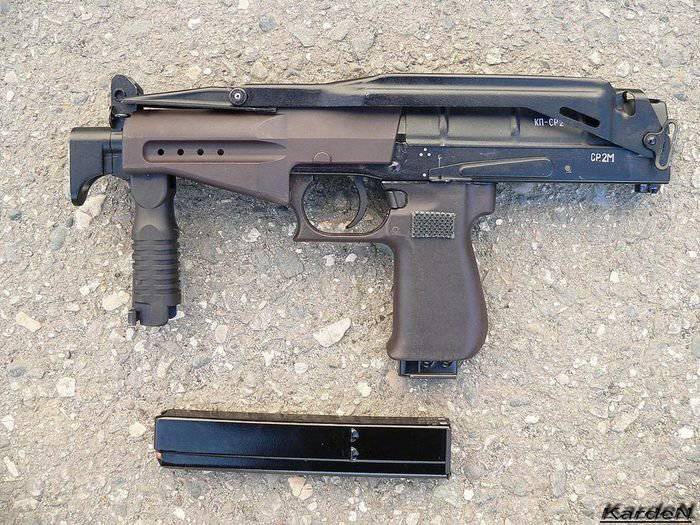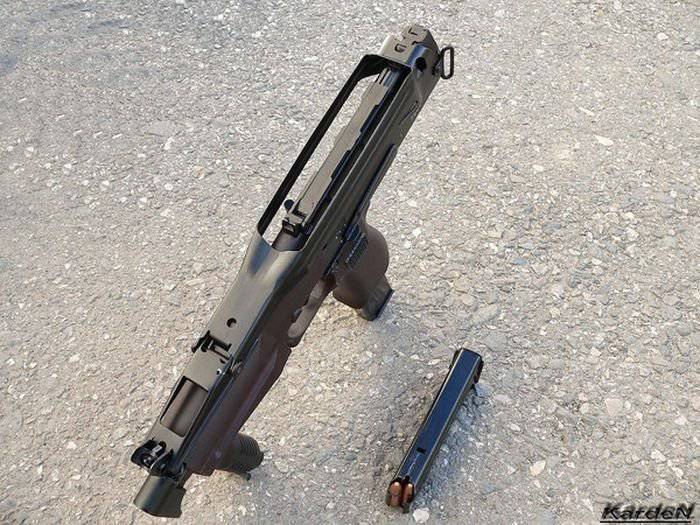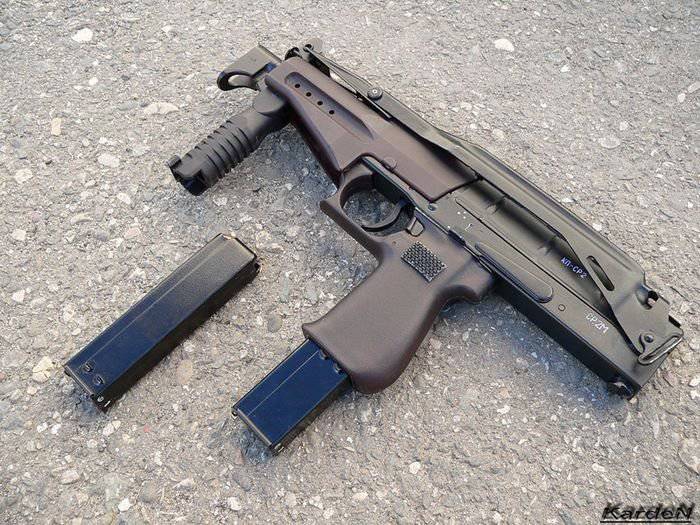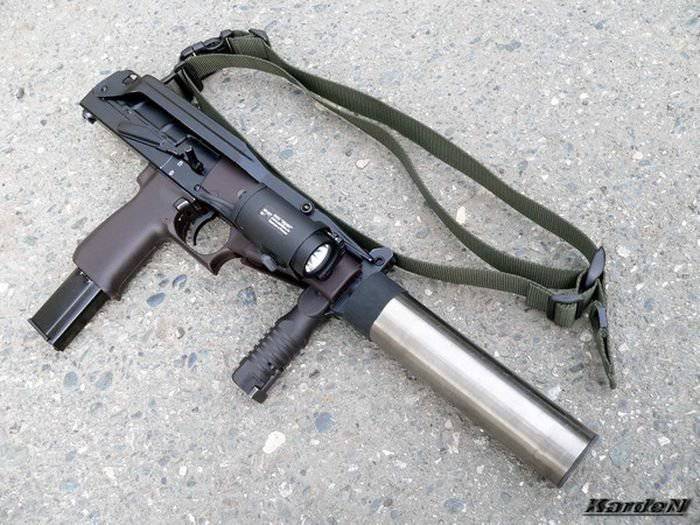Submachine gun CP-2 "Heather"
In the USSR, attention was also paid to the development of self-defense weapons, but special programs like PDW were never announced here. In addition, for these purposes at that time the APS, the Stechkin automatic pistol, was well suited. And in the late 70s, the AKS-74U assault rifle was adopted. It was used for the same purposes as foreign counterparts, but due to its significant weight and size characteristics, it did not pull on a real PDW.
A breakthrough in the development of such weapons in Russia came only in the second half of the 1990s. It was accompanied by the development at TsNIItochmash of a new Russian pistol cartridge 9x21 mm, which was distinguished by a high lethal and penetrating effect. At the same time, the increase in the striking abilities of the bullet was achieved not only due to an increase in the initial speed of its flight, but also due to the special design of the cartridge. The new 9x21 mm cartridge, according to the developers, was supposed to completely replace the standard 9x18 mm cartridge for the Makarov pistol (PM). Specially for the new cartridge, specialists from TsNIItochmash designed the SR-1 pistol (unofficially called Gyurza).

The success achieved when creating a pistol for a new cartridge allowed specialists from Klimovsk to start work on another promising model, which later received the designation SR-2 Veresk submachine gun. The development of the submachine gun was completed in 1999. Currently, Veresk is in service with the FSO of Russia, the FSB (the Vympel detachment), as well as a number of special forces of the Russian Ministry of Internal Affairs (for example, in the Moscow OMON).
Naturally, while working on a new automatic weapon for a completely new cartridge, the designers of the enterprise analyzed and considered several different automation schemes. The use of a powerful cartridge required extraordinary solutions from them. They chose a relatively rare automation system for this type of weapon, which provided for the removal of part of the powder gases from the barrel bore, the barrel was locked by turning the bolt. Due to insufficient funding, work on the creation of a submachine gun dragged on, the first prototypes were ready only in mid-1998.
It should be noted that Veresk was originally developed to solve a wide range of tasks. Among them is the defeat of enemy manpower in personal protective equipment of the 2nd class at a distance of up to 200 meters, as well as unarmored vehicles at a distance of up to 100 meters. For this, it was planned to use several types of different 9x21 cartridges with different bullets: SP10 (increased armor penetration with a bullet with a special steel core); SP11 (with a low recoishing bullet having a lead core). SP12 (expansive bullet with increased stopping power); SP13 (tracer bullet). According to weapons experts, the damaging effect of the SP-11 and SP-13 cartridges was 1,5-2 times higher than that of the widely used PM cartridges. The use of an armor-piercing bullet allows you to pierce a 100-mm steel sheet at a distance of up to 4 meters with a 70% guarantee.

The Veresk submachine gun significantly expands the tactical capabilities of the Gyurza pistol. At one time, the SP-10 armor-piercing cartridge, the SP-11A ordinary cartridge, the Gyurza pistol and the Veresk submachine gun, as well as their common collimator sight, were presented by TsNIItochmash as a special rifle complex of increased efficiency, mainly intended for special services . The hitting accuracy, power and ammunition load of the Veresk SS are sufficient to achieve a qualitative superiority over the enemy. When using this complex, a preemptive effect is also achieved in the event of a possible fire duel. The use of collimator sights provides a fairly high aiming speed - 2-3 times faster than when using traditional "bear" sights.
The Veresk submachine gun operates on the basis of gas automatics and has a long stroke of the gas piston. In this case, the gas piston located above the barrel is rigidly connected to the bolt frame. The piston is hollow, a return spring is placed inside the piston with the front part. The barrel is locked by the cutouts located in the receiver by turning the bolt with 6 lugs. At the time of the shot, the gas piston and bolt frame move back, turning the bolt. After that, the barrel of the submachine gun is unlocked and the spent cartridge case is ejected, then the bolt sends the next cartridge into the chamber and the bore is locked. At the same time, an automation system with a hard locking of the bore in modern submachine guns is very rare. This decision was due to the use of a powerful cartridge. The cocking handle is rigidly attached to the bolt carrier on the right.
In front of the forearm of the SR-2 "Veresk" there is a holding handle. The submachine gun uses a trigger-type trigger mechanism, which allows you to fire both bursts and single shots. The safety lever is located on the receiver on the right and has two positions, which are marked with the letters "P" - fuse and "O" - fire. The lever for the translation of types of fire is located on the left side. Like the fuse, it also has 2 positions, which are marked with one and three dots - single and automatic fire, respectively. The submachine gun is equipped with a folding metal butt, which folds up in the stowed position.

The Vereska buttstock has a spring-loaded recoil pad, which reduces the time it takes to transfer the weapon from the marching to the combat position for firing with an emphasis on the shoulder. The method of placing the stock in the folded state allows to reduce the transverse dimensions of the weapon. Together with the Veresk submachine gun, detachable box magazines for 20 or 30 rounds can be used. The location of cartridges in stores is staggered. Box magazines are installed in the pistol grip fire control.
The sighting device SR-2 consists of a front sight and a two-position rotary rear sight, which can be set to 100 and 200 meters. The front sight of the sight is placed in a high rack, it can be moved in a vertical and horizontal plane to bring the submachine gun to normal combat. Also on the top of the receiver is a bracket that can be used to mount a red dot sight. Its use greatly facilitates the process of aiming a weapon at a target, especially in low light and when shooting at moving targets.
A compensator is located in the muzzle of the submachine gun barrel, on top of this compensator there is an inclined cut. The use of such a compensator allows you to effectively fire, even if the shooter holds the "Heather" "like a pistol" (both with one and two hands). The small weight and size characteristics of the SR-2M, combined with the axillary suspension of the original form, provide a quick transfer of the weapon to the firing position, as well as convenient transportation. Also, "Heather" can be carried on a belt, which is attached to the front and rear swivels.

The main advantage of CP-2 "Heather" is very high firepower, high accuracy of shooting and high striking effect of a bullet at close range combat. The combination of these qualities made this submachine gun a very attractive model for employees of Russian special forces as a weapon of self-defense. "Heather" meets all the requirements that apply to weapons of class PDW in the West.
The first serial submachine guns CP-2 were distinguished by low quality, non-interchangeable shops, general “dampness” of the structure, as well as permanent minor malfunctions. All this caused a large number of complaints from users of submachine guns, who at the same time noted the overall prospects of development when bringing it to the required level of reliability.
Currently, the SR-2 version is not available. TsNIITochmash is engaged in the production of versions of the SR-2M and SR-2MP. The upgraded sample SR-2M has a number of differences from the original model: instead of a hard stop on the forearm, a folding front handle appeared, which increases the accuracy of fire and controllability of the weapon (in the folded position, the handle becomes part of the forearm); instead of a muzzle brake-compensator, a muzzle-stop is used, which protects the shooter's hand from moving forward and possible burns by powder gases; the fuse box has been slightly changed. The SR-2MP version is distinguished by the installed Picatinny rails, which are mounted on the forearm and receiver. In addition, this version can be equipped with a modified buttstock and a silencer.
Tactical and technical characteristics of CP-2 "Heather":
Caliber - 9 mm; used cartridge - 9x21 mm.
Length: with butt - 603 mm, with folded butt - 367 mm.
Weight - 1,65 kg.
The initial speed of the bullet - 415-440 m / s.
Magazine capacity - 20, 30 cartridges.
Firing rate - up to 900 shots / min.
Target range - to 200 m.
The source of information:
http://otvaga2004.ru/kaleydoskop/kaleydoskop-inf/veresk-nash-otvet-pdw
http://www.armoury-online.ru/articles/smg/ru/sr-2m
http://www.megasword.ru/index.php?pg=314
http://www.tsniitochmash.ru
Information